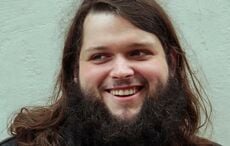A remote farmhouse in serene rural Cork, a beautiful French filmmaker, an Englishman with a history of domestic abuse and possible foul-play by the Irish police may seem like the perfect thriller storyline but, unfortunately for residents of Schull in west County Cork, that is the real-life horror visited upon quiet village for almost the past two decades.
In one of Ireland’s most intriguing unsolved murder cases, a neighbor discovered the battered, beaten corpse of French filmmaker, Sophie Toscan du Plantier, on December 23, 1996, the same day she was due to leave her west Cork five-bedroom farmhouse to join her husband, famous French filmmaker Daniel du Plantier, for Christmas in West Africa.
It is now more than eighteen years later and Ian Bailey, the man arrested twice in connection with her murder, has just lost a civil action case taken against the Irish police force (An Garda Síochána), the Minister for Justice and the Attorney General for damages in a trial that saw a previous key witness for the Irish police claiming interference with her evidence.
Following the loss, Bailey could now face a legal bill in the millions when a decision on costs is made on April 13.
That’s unless the case is thought to be in the public interest, however. Then the bills will fall at the feet of the Irish taxpayer. This would add to the $54.2 million that members of the Irish parliament were told had already been spent on pursuing Bailey.
Despite the successful result for the Irish state, it would be hard to deny that any case built by the Cork police against Bailey has been greatly harmed by the evidence heard in the 64-day trial.
Bailey, a 58-year old Englishman, moved to West Cork in 1991, where he worked occasionally as a freelance journalist. He was, in fact, one of the first at the murder scene on December 23, 1996, when he was asked to report on the discovery of Sophie’s body for the Irish Examiner.
Bailey was arrested twice in connection to the murder: once in 1997, and again 1998, but no charges have ever been brought against him.
By January 1997, the police investigation had ruled out many of their main suspects including an ex-lover of Sophie’s and a local peeping-tom, leaving Bailey as the main suspect, and both Irish and French detectives have continued to pursue a case against him.
Since 2010, there has been a European arrest warrant in place for Bailey, as French magistrate Patrick Gachon seeks his extradition to France. Because of this, Bailey has been unable to leave Ireland, not even to attend his own mother’s funeral in England, for fear of arrest as soon as he touches down in another European airport.
For years, Bailey claimed he was set up and, as reported by The Independent, in a 2001 review of the case, the Director of Public Prosecutions (DPP), Eamon Barnes, claimed that, “There is now a real possibility that Bailey may be charged in France and perhaps receive a lengthy prison sentence presumably, inter alia, on evidence and conclusions provided by what I regarded at the time as having been a thoroughly flawed and prejudiced investigation, culminating in a grossly improper attempt to achieve or even force a prosecutorial decision which accorded with that prejudice."
The DPP’s 2001 review of the case virtually dismissed all of the circumstantial evidence built against Bailey from the credibility of the witnesses (one a 14-year old boy) to the scratches on his arm and highlighted his willingness to provide fingerprint and blood samples.
In the latest civil case, the police investigation was battered further with the evidence of Garda whistleblower John Wilson. The Guardian reports that during the trial he said, “They were collating information on him, tracking him, in such a way as you would a serious criminal, not someone who was framed for a murder he did not commit. They collated him going to university, and trailed his partner too. The information presented to me suggests this was high-level, orchestrated harassment, yet they failed to investigate the actual murder.”
The DPP review highlighted an incident in which the police paid, and supplied drugs to, a British soldier-turned-addict in a hairbrained scheme to a draw a confession out of Bailey on tape while high.
This story was seconded by former key police witness, Marie Farrell, who testified during the civil case as having signed forty-eight blank pages for the police. On these pages, she believes the police later wrote a false statement in which she confirmed seeing Bailey walking in the area of the du Plantier farmhouse on the night of the murder.
Farrell was established as an original key witness when she stated that she had seen a man believed to be Bailey at 3am at the scene of the crime on the night of the murder. Her original statement also said that she had seen the same man outside her shop watching while Ms. du Plantier was inside.
Farrell first called the police anonymously in 1996 to say she’d seen a man close to Sophie’s farmhouse. She had apparently been reluctant to openly come forward about her whereabouts as she did not want her husband to know that she had been having a drink with a married friend. Following a crime call investigation in 1997, she contacted police anonymously again until they were able to trace her back to her home and asked her to give a statement. She was told she would never have to testify in court.
During her latest evidence, Farrell states that police informed her they knew that it was Bailey she saw that night. "Just say it was him that you saw, we know it was him," she said. The Daily Beast reports that she continued to say that they also led her to believe Bailey was dangerous and strange, “a man who would howl at the moon and had sat in a rocking chair on Barleycove beach with ten lesbians dancing around him.”
She revealed that during her talks with police, she was introduced to the late Senator Peter Callanan who told her a council house in Schull "would be sorted." She informed the jury that they later acquired a house.
After her police discussion about a statement, she agreed to sign blank pages before she left the station, saying in her new evidence, “To be honest, I didn’t give it much thought really.” When shown the original statements confirming her sighting of Bailey, she said she believed them to have been written on the blank pages she signed.
In 2005, she withdrew her original statement and contacted Bailey’s lawyer. She now claims that she does not know who the man she saw was, that he “stood out as being a stranger” but that it was not Ian Bailey. Farrell had previously approached Bailey in a bar in 1997 telling him that the police were trying to set him up.
Bailey has previously been charged with domestic abuse against his partner of many years, Jules Thomas, the details of which came to light during various libel cases taken by Bailey against Irish and British newspapers. On three separate occasions between 1993 and 2001, Thomas was hospitalized as a result of beatings allegedly suffered at the hands of Bailey.
Despite restraining orders taken by Thomas against Bailey and a short time in jail because of these assaults, the couple remain together and currently live in the same home they occupied in 1996 when Sophie was murdered. Bailey has claimed that whiskey was the reason for these vicious attacks on his partner and he has since given up drinking.
He told The Daily Beast, “My behavior was shameful and disgraceful. I have said that over and over and I have fixed it. There are no excuses for it but at the same time it is not that unusual in this locality and many others. It does not mean I’m a murderer.”
The nature of Sophie’s relationship with her husband has also spent its time in the spotlight. The couple apparently shared an open marriage and she occasionally brought other lovers to accompany her on a stay in her Cork farmhouse. Her final trip to Cork, however, was unaccompanied.
One such lover was included in the first ten men the police presented as suspects in her death, along with Bailey. French artist Bruno Carbonnet, Sophie’s lover for over a year, believed that her husband was aware of their affair and that an agreement was reached between Sophie and Daniel that involved husband and wife attending certain events together. Despite the complications of her private life, police were unable to find any clues in the hunt for her killer. The DDP review, however, mentioned Carbonnet specifically as a suspect.
Many theories have floated around the throughout the past 18 years and jurors in the recent civil action case were warned not to engage in their own online research about the case. Despite the changing of statements and the review of the DPP, the jury’s conclusion last week found in favor of the Irish state. They did not feel police had conspired to obtain false statements from Farrell through threats, intimidation and inducements which would place Bailey at the scene of the crime on the night of the murder, nor had they attempted to get statements from Farrell alleging that Bailey had intimidated her.
Du Plantier’s family is still actively seeking justice. The Daily Beast reports that French detectives are believed to be ready to again travel to Ireland this year in renewed attempts to extradite Bailey although, according to French law, he can still be tried in absentia.




Comments